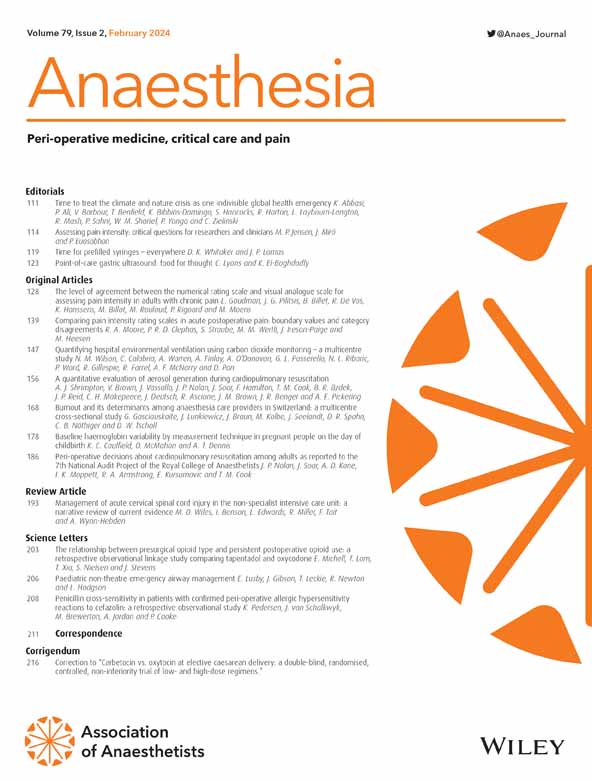经导管心脏瓣膜干预的麻醉支持:叙述性回顾
IF 7.5
1区 医学
Q1 ANESTHESIOLOGY
引用次数: 0
摘要
在过去的二十年中,很少有其他医疗实践领域与经导管心脏瓣膜干预一样发展迅速。除了提供围手术期护理外,麻醉师还是“心脏团队”的核心成员,他们计划和管理瓣膜性心脏病患者的护理。这篇综述的目的是总结麻醉医师这些程序的核心信息。方法:我们进行了一项文献综述,以确定近五年来发表的关于经导管主动脉瓣、二尖瓣、肺动脉瓣和三尖瓣介入治疗患者的围手术期管理的高引用或高Altmetric评分的文章。结果当代发表的比较或推荐麻醉技术以及描述麻醉技术对围术期预后影响的证据很少。相反,在接受经导管手术的特定患者风险群体中,有大量证据表明其结果。然而,这些试验主要关注死亡率和并发症,获得了大量的行业资助,并使用频率非劣效性方法将不良结果汇总为综合结果。大多数现实世界的患者可能会被排除在这些试验之外,因此临床医生应该运用证据、专业知识和当地经验,对转到心脏团队的个体患者做出风险/收益判断。对于麻醉师来说,关于诊断、患者选择、程序步骤和设备设计特征的知识可以说比局部麻醉渗透、有意识镇静和全身麻醉的具体技术更重要,这些都是所有成年麻醉师可转移的技能。有必要开展新的围手术期研究,重点关注以患者为中心的指标,而不是并发症和死亡率结果。在临床上,越来越多的人关注以患者为中心的治疗,干预的时机和以团队为基础的方法,更强调合并症及其积极的管理。本文章由计算机程序翻译,如有差异,请以英文原文为准。
Anaesthesia support for transcatheter heart valve interventions: a narrative review
SummaryIntroductionThere have been few other areas of medical practice in the last two decades that have evolved at the same pace as transcatheter heart valve interventions. As well as providing peri‐operative care, anaesthetists are core members of ‘Heart Teams’, who plan the care of and manage patients with valvular heart disease. This review aims to summarise core information on these procedures for anaesthetists.MethodsWe conducted a literature review to identify highly cited or high Altmetric scoring articles published in the last five years on the peri‐operative management of patients undergoing transcatheter aortic, mitral, pulmonary and tricuspid valve interventions.ResultsThere was little contemporary published evidence comparing or recommending anaesthetic techniques and describing their effect on peri‐operative outcomes. Instead, there is a wealth of evidence on outcomes in specific patient risk groups undergoing transcatheter procedures. However, these trials focussed mainly on mortality and complications, received substantial industry funding and pooled adverse outcomes as a composite using frequentist non‐inferiority methods. Most real‐world patients would likely be excluded from these trials and clinicians therefore should apply evidence, expertise and local experience to make risk/benefit judgements for individual patients referred to the Heart Team. Knowledge of the issues around diagnosis, patient selection, procedural steps and device design characteristics are arguably of more importance to the anaesthetist than the specifics of techniques for local anaesthesia infiltration, conscious sedation and general anaesthesia, which are transferrable skills for all adult anaesthetists.DiscussionThere is a need for new peri‐operative research with a focus on patient‐centred metrics, rather than complication composites and mortality outcomes. Clinically, there is increasing focus on patient‐centred treatment, timing of interventions and a team‐based approach with greater emphasis placed on comorbidities and their aggressive management.
求助全文
通过发布文献求助,成功后即可免费获取论文全文。
去求助
来源期刊

Anaesthesia
医学-麻醉学
CiteScore
21.20
自引率
9.30%
发文量
300
审稿时长
6 months
期刊介绍:
The official journal of the Association of Anaesthetists is Anaesthesia. It is a comprehensive international publication that covers a wide range of topics. The journal focuses on general and regional anaesthesia, as well as intensive care and pain therapy. It includes original articles that have undergone peer review, covering all aspects of these fields, including research on equipment.
 求助内容:
求助内容: 应助结果提醒方式:
应助结果提醒方式:


